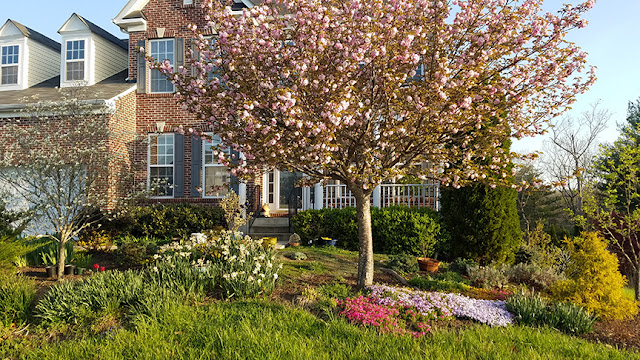 |
| My front yard on April 24 |
Here's my annual photo of the front yard with its Kwanzan cherry tree in full bloom, which I like to post every year. This year the cherry blossoms didn't open fully until last Sunday, a full week after Easter Sunday. In other years it has bloomed a couple of weeks earlier, so that the progression of the other flowers in the front changes according to the timing of the cherry: the narcissi, the creeping Phlox, tulips and the dogwood have bloomed simultaneously on some years, on others, not so much.
This is the most beautiful time of the year for me, when just about everything comes into bloom. On the east side of the house, my Carolina Silverbell tree grows more beautiful every year! The 17-year locusts damaged the Japanese maples quite a bit last year, and they lost some growth at the tips of their branches, but hopefully they will recover this year.
 |
| East yard with Japanese maples and Carolina Silverbell tree. |
 |
| Carolina Silverbell flowers. |
My hybrid Rhododendron 'Southgate Brandi' has just opened its flowers. This one is growing nicely, thanks to the winter protection of my barriers--otherwise deer would have devoured the buds as they were developing.
 |
| Rhododendron 'Southgate Brandi' |
 |
| Ajuga 'Black Scallop' ground cover. |
I am hoping soon to see the flowers of another Rhododendron I planted several years ago, 'Anna Rose Whitney' has not produced any blooms before.
 |
| The back yard from our deck. |
The redbud tree in the back yard was in full bloom this past week along with the double flowering quince. The border of narcissi in the back bed looks fuller this year than last. Sadly, my beautiful Korean fir 'Horstman's Silberlocke' died sometime during the winter--probably from lack of water during February's dry spell while I was away. I didn't know that when clay soil dries out, it can actually begin a reverse osmosis process where the soil will take moisture away from a plant's roots. Last week I received a new tree to replace the dead one--hope springs eternal in a gardener's heart!
 |
| Lewisia longipetala 'Little Peach' |
 |
| Lewisia |
The Lewisia continues to bloom prolifically, it's such an interesting plant. Originating in the alpine areas of California's Sierra Nevada, it's quite rare in its native environment, but the modern hybrids, such as this one, are a great addition to rock gardens. I keep mine in a pot because it needs excellent drainage which my clayey soil can't provide.
It's so wonderful to see tender green shoots sprouting everywhere! Lots more blooms to come in May!










































